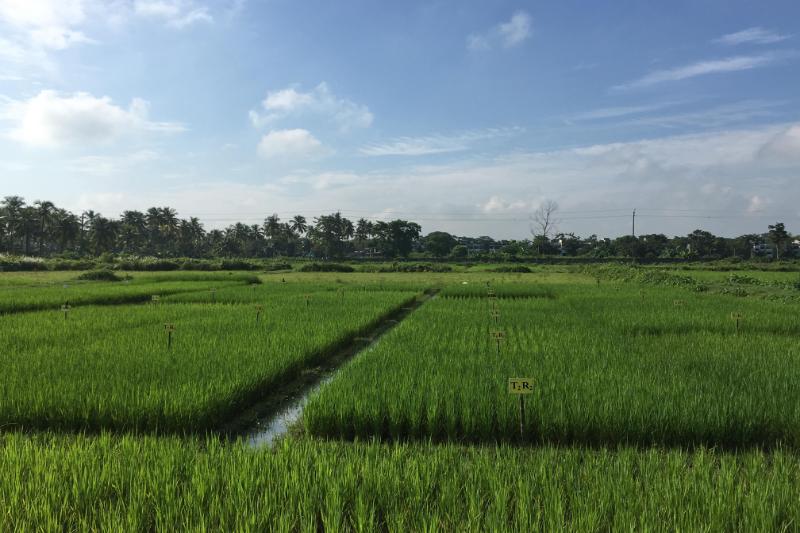Optimizing rice nutrition through post harvest processing

A BBSRC-GCRF project led by Professor Andrew Meharg from School of Biological Sciences
What is the project about?
The objectives of this research are that each stage in the post-harvest production of rice in Bangladesh can be optimised, using low-cost & low-tech interventions, to improve both the volume & nutritional quality of rice in circulation, directly challenging the double burden of malnutrition caused by a subsistence rice diet. Rice in Bangladesh is generally consumed in the parboiled state, and intervention at the parboiling stage is known to enhance nutritional quality. Also, the degree of milling is important, with wholegrain rice being much healthier than highly polished with respect to nutritional density and dietary fibre. There are strong differences in the degree of milling currently available in Bangladesh, with subsistence farmers preferring wholegrain, and the urban and rural poor consume highly polished rice. Decreasing the degree of milling is key to enhancing both health benefits and yield of rice reaching the consumer for subsistence rice diets. However, inorganic arsenic is elevated in wholegrain & needs its removal optimised, which we have shown in preliminary studies can be done at the parboiling stage. Also, changing post-production of rice needs to consider microbial safety, primarily Bacillus cereus, a widespread cause of food poisoning, to ensure its prevalence does not rise on alteration of rice processing.
What were the project outcomes?
i. To modify parboiling to maximize mineral nutrients & vitamins, across a range of products in relation to the degree of milling, from wholegrain to highly polished.
ii. To enhance the yield of rice through decreasing the degree of milling, leading to enhanced national food security.
iii. To maintain or enhance the microbial safety of rice when altering post-harvest processing.
iv. To maximize the removal of inorganic arsenic through post-harvest processing, counterbalanced with enhancing nutrients.
v. To optimize the product(s) developed through aims i-iv meet consumer acceptance, amongst the subsistence farmers & landless rural & urban poor.
vi. Communication of findings to mill owners, target populations, government, NGOs, & researchers.
ODA - Direct benefit?
The subsistence farmers and urban and rural poor are malnourished in terms of mineral nutrients and vitamins. Bangladesh has among the highest per capita rice consumption in the world at 420g/d. Although rice is an important dietary source for a range of macro- and micro- essential elements, and for a range of B-Vitamins (B1, B2, B3, B5, B6, B9), it undersupplies the majority of these, while oversupplies carbohydrate. Also, there is a need to produce more rice as the population is growing while agronomic landmass is shrinking, and labour is moving from the countryside to the cities. The low nutritional value of rice and its oversupply of calories, along with concerns about enough being produced to feed the populace, is a classic example of the double burden of malnutrition. The carbohydrate oversupply is thought to be behind a rise in type-2 diabetes amongst the urban poor of Bangladesh. Calcium and vitamins B1, B3, B6 & B9, and dietary fibre all have a role in counteracting type-2 diabetes, so if these, and other nutrients present in rice, can be enhanced in they will be highly beneficial with respect to rice be a causative agent of diabetes, while also being generally beneficial in fighting malnutrition in general.
This research sets out the research needed to improve both the volume and the nutritional quality of rice produced in Bangladesh that reaches the consumer through altering post harvesting processing. Most rice is eaten parboiled in Bangladesh meaning that this centralized process can be optimised to enhance nutritional value of this commodity that has a wide reach to the populace, in general. Milling preference varies quite widely in Bangladesh, with the urban and rural landless poor eating mainly highly polished rice, and subsistence farmers wholegrain or highly polished.
Parboiling generally enhances both elemental and B-vitamins in rice, while polishing removes both organic and inorganic nutrients, along with dietary fibre. Our preliminary, conducted throughout Bangladesh) studies show that we can enhance calcium by 100% in milled rice by parboiling wholegrain, as opposed to rough rice, while removing 25% of the carcinogen inorganic arsenic (a wide-scale problem in rice, particularly in Bangladesh), and lowering of Bacillus cereus (a widespread cause of food poisoning from rice) infection of subsequently cooked rice. Thus, optimising parboiling is a way to enhance the nutritional status of rice, across minerals and vitamins. Also, subsistence farmers have a preference for wholegrain or lightly milled rice, and if milling degree can be lowered for market rice consumed by the rural and urban poor, testing at all stages consumer acceptance, this will have double benefit in fighting the double burden of nutrition that rice poses, enhancing the potential health benefits of rice (miner nutrients, B-vitamins, dietary fibre), while enhancing the yield of rice that actually reaches market through less wastage as bran. The grant's work plans will systematically set out the optimal post-harvest treatment of rice to address the double burden of nutrition.